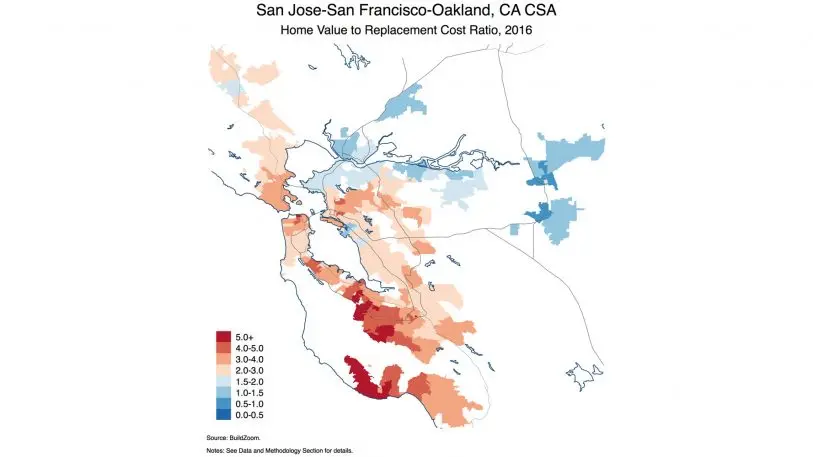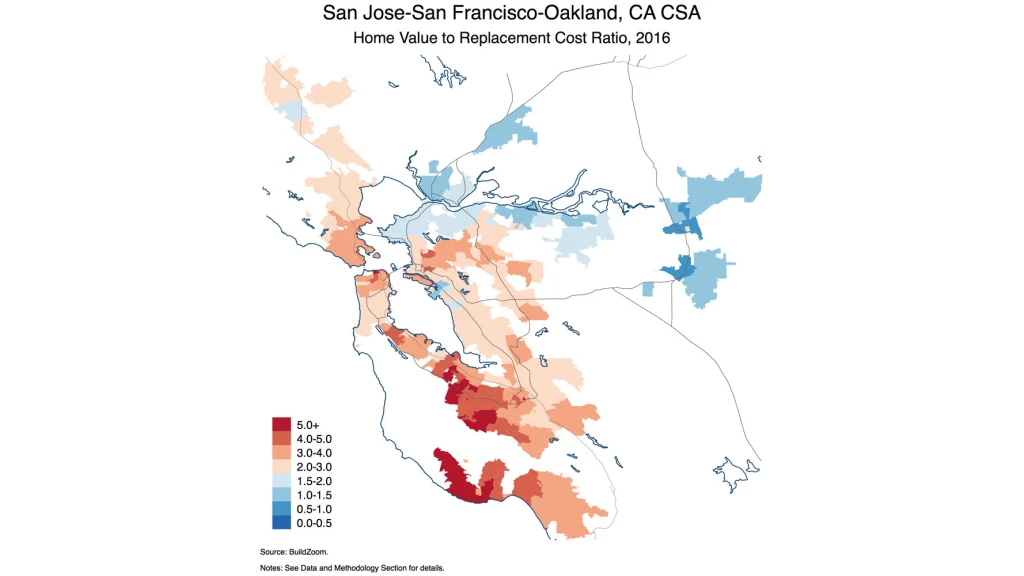It’s often said that cities like San Francisco and New York are expensive because they lack housing. Lots of people want to move there to live and work, which pushes up prices. But this argument isn’t completely accurate. The cost of housing is also a reflection of the way cities do and don’t allow new development, economists say.
Between 1980 and 2010, San Francisco’s housing prices surged by roughly 200%. Partly that was because the city put aside only 30% more land for new buildings over that time (much less than more “expansive” places). In the name of preservation and “character,” San Francisco resisted changing its fundamental design pattern. Rather than building higher and filling in available space (“densifying”), it largely maintained its traditional low-rise look-and-feel.

Issi Romem, chief economist at BuildZoom, a construction marketplace, points out that the Bay Area actually has plenty of space to build if it wanted it. He estimates that 75 to 100 million people could live in the metro region, if it adopted the same people-per-mile density of Manhattan or Paris.
Romem argues that high land prices are reflective of restrictive zoning that reduces affordability. In cities like San Francisco and San Jose, the cost of constructing houses is relatively small compared to the cost of acquiring the underlying dirt.
“High home value to replacement cost ratios are a good indication that the housing supply is restricted, meaning that people who are willing and able to pay enough to support new housing construction are being excluded by limits on density,” Romem writes in a blog post.
Property values in San Francisco are roughly three times the cost of replacing just the home sitting on the land, according to Romem’s analysis of dozens of metro areas. Most of the value is in the terra firma, not the woodwork.
The San Jose metro area, including Silicon Valley, has the highest home-value-to-replacement cost ratio (3.74) of any U.S. metro followed by the San Francisco area (a ratio of 2.98), and Washington D.C., New York, and Los Angeles (2.63, 2.62 and 2.53 respectively). By contrast, Buffalo, in New York State, has a ratio below 1–meaning buildings are more valuable than land on average. In 2016, the average house price in San Jose was $1.1 million, while the average in Buffalo was just $167,000–an almost seven-fold difference.
 Romem notes that even cities with lower ratios have areas where homes are very expensive and land values are sky-high. Houston, for example, has an overall ratio of 1.54, but it has areas where its ratio exceeds 5. These cities may have done a good job of keeping up with housing demand and keeping prices reasonable in the last few decades. But they’ve maintained enclaves where only the relatively rich or old maintain residences.
Romem notes that even cities with lower ratios have areas where homes are very expensive and land values are sky-high. Houston, for example, has an overall ratio of 1.54, but it has areas where its ratio exceeds 5. These cities may have done a good job of keeping up with housing demand and keeping prices reasonable in the last few decades. But they’ve maintained enclaves where only the relatively rich or old maintain residences.
In an interview, Romem says cities face an intractable “trilemma” between the needs of preservation, avoiding sprawl, and encouraging affordability. It’s impossible to have all three, but it is possible to achieve two goals–greater affordability and less sprawl–through densification policies. He thinks those goals are more important than less tangible principles like “maintaining the character of a neighborhood.”
To densify, he suggests cities can allow taller buildings. They can “upzone” from industrial permits to residential buildings with plenty of units. And they can resist hyper-local interests who want to restrict development. Even holding planning meetings in the evening, as opposed to the afternoon, can help push development forward. (A 5 p.m. weekday meeting is more likely to attract older, long-time residents, who have free time and are more likely to resist development; evening meetings are more suitable for, say, young parents who might approve it.)
Regional or state bodies are more likely to take a holistic view on planning , including on the issue of affordability. “Opposition to development in general is very localized,” Romem says. “People who approve of development are [more likely to be] spread throughout metros, or they’re not born yet. Both groups don’t have a voice [in local planning decisions].”
Recognize your brand’s excellence by applying to this year’s Brands That Matter Awards before the early-rate deadline, May 3.







